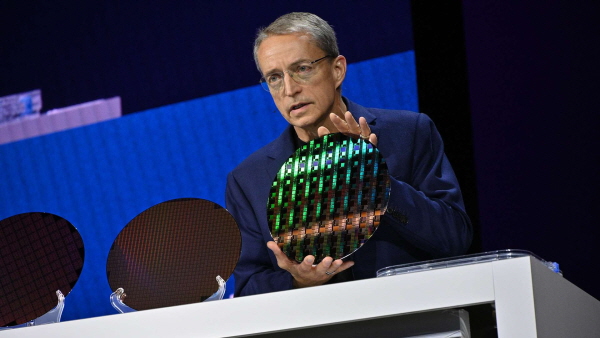인텔이 연례 개발자 행사인 세번째 인텔 이노베이션(Intel Innovation)을 美 캘리포니아주 산호세에서 개최하며, 클라이언트, 엣지, 네트워크 및 클라우드에 이르는 모든 워크로드에서 인공지능 접근성을 높이고 사용할 수 있도록 지원하는 다양한 기술을 공개했다.
EMIB 첨단 패키징 기술 사용 UCle 기반 테스트 칩 선
2024년 애로우 레이크 테스트 칩·인텔20A 웨이퍼 공개
5세대 인텔® 제온®프로세서 오는 12월14일 출시 예정
팻 겔싱어(Pat Gelsinger) 인텔 CEO가 무어의 법칙(Moore’s Law) 다음은 멀티칩렛 패키지와 함께 도래할 것이라며 유니버설 칩렛 인터커넥트 익스프레스(UCIe) 기반 테스트 칩 패키지도 선보였다.
인텔은 19일 연례 개발자 행사인 세번째 인텔 이노베이션(Intel Innovation)을 美 캘리포니아주 산호세에서 개최했다.
인텔은 올해 행사에서 클라이언트, 엣지, 네트워크 및 클라우드에 이르는 모든 워크로드에서 인공지능 접근성을 높이고 사용할 수 있도록 지원하는 다양한 기술을 공개했다.
우선 겔싱어 CEO는 인텔이 발표했던 4년 간 5개 노드 공정을 개발한다는 목표가 차질없이 진행되고 있다고 밝혔다.
현재 인텔7 공정으로 이미 대량 양산이 진행 중이고, 인텔4 공정이 제조 준비를 마쳤으며, 인텔3은 올해 말까지 제조 준비를 완료할 예정이라고 밝혔다.
겔싱어 CEO는 2024년 PC 시장을 공략할 인텔 애로우 레이크(Arrow Lake) 프로세서용 첫 번째 테스트 칩과 인텔20A 웨이퍼를 공개했다.
인텔20A는 후면 전력 공급 기술인 파워비아(PowerVia)와 리본펫(RibbonFET)으로 불리는 새로운 게이트 올 어라운드(GAA) 트랜지스터 디자인이 적용된 최초의 공정이다.
파워비아 및 리본펫을 활용할 두번째 공정인 인텔 18A도 2024년 하반기에 생산 준비를 완료할 전망이다.

▲인텔 펫 겔싱어 CEO가 18A 공정 노드 웨이퍼를 공개하고 있다.
인텔은 이번 주 발표한 또 하나의 혁신인 유리 기판과 같은 새로운 재료와 새로운 패키징 기술을 통해서 다른 방법으로 무어의 법칙(Moore’s Law)을 이어나간다.
유리 기판은 2030년 이후에도 패키지에 담을 수 있는 트랜지스터의 수를 지속적으로 증가시키며 인공지능과 같은 데이터 집약적이고 높은 성능이 필요한 워크로드 요구사항을 충족시키는 데 도움이 될 것으로 예상된다.
인텔은 이날 유니버설 칩렛 인터커넥트 익스프레스(UCIe) 기반 테스트 칩 패키지도 선보였다.

▲인텔 펫 겔싱어 CEO가 UCle로 만든 테스트 칩 패키지를 공개하고 있다.
겔싱어 CEO는 개방형 표준이 IP 통합을 보다 용이하게 한다면 무어의 법칙의 다음 단계는 멀티칩렛 패키지와 함께 도래할 것이라고 밝혔다. 지난해 공개된 UCIe 표준은 다양한 공급업체가 제작한 칩렛이 함께 작동할 수 있도록 지원해 다양한 AI 워크로드의 확장을 위한 신규 설계 구현을 가능하도록 한다. 현재 UCIe 표준에는 120개 이상의 기업이 참여하고 있다.
인텔이 이날 발표한 테스트칩은 인텔3 기반 인텔 UCIe IP 칩렛과 TSMC N3E 공정 기반 시놉시스(Synopsys) UCIe IP 칩렛을 결합했다. 칩렛은 내장형 멀티다이 인터커넥트 브릿지(EMIB) 첨단 패키징 기술을 사용해 연결했다. 인텔은 기술 시연을 통해 TSMC, 시놉시스 및 인텔 파운드리 서비스(IFS)의 UCIe 기반의 개방형 표준 기반 칩렛 생태계 지원 의지를 강조했다.
이날 인텔은 5세대 인텔 제온 프로세서를 12월14일에 출시해 전 세계 데이터 센터에 더욱 향상된 성능과 더욱 빠른 메모리와의 조합을 제공할 것이라고 공개했다.
2024년 상반기 선보일 예정인 E-코어의 효율성을 갖춘 시에라 포레스트(Sierra Forest)는 4세대 제온 프로세서 대비 2.5배 높은 랙 밀도와 2.4배 높은 와트당 성능을 제공하며, 288개 코어2를 갖춘 제품도 공개할 예정이다.
시에라 포레스트와 유사한 시기에 출시 예정인 고성능 P-코어 기반 그래나이트 래피즈(Granite Rapids)는 4세대 제온 프로세서 대비 2∼3배 빠른 AI 워크로드 성능을 제공할 것으로 보인다.
2025년에 출시 예정인 차세대 E-코어 기반 제온 프로세서(코드명 클리어워터 포레스트)는 인텔18A 공정 기반으로 생산할 예정이다.
인텔 코어 울트라 프로세서를 탑재한 AI PC도 소개됐다.
인텔은 첫 번째 통합형 신경처리장치 또는 NPU(neural processing unit)를 탑재한 인텔 코어 울트라 프로세서(코드명 메테오 레이크)를 바탕으로 새로운 PC 경험을 제공한다.
NPU는 PC에서 전력 효율적인 AI 가속 및 로컬 추론 기능을 지원한다. 겔싱어 CEO는 인텔 코어 울트라 프로세서가 오는 12월14일 출시될 것이라고 밝혔다.
인텔 코어 울트라 프로세서는 인텔 PC용 프로세서 로드맵의 주요한 기점을 나타낸다. 해당 프로세서는 인텔 포베로스(Foveros) 패키징 기술을 적용한 최초의 PC용 칩렛 기반 제품이다.
NPU 및 인텔4 공정 기술을 바탕으로 전력 효율성이 크게 향상되었으며, 내장형 인텔ⓡ 아크™ 그래픽으로 외장 그래픽과 동등한 수준의 그래픽 성능을 제공한다.
겔싱어 CEO는 무대에서 다양한 AI PC 사용 사례를 선보였으며, 제리 카오(Jerry Kao) 에이서 최고운영책임자(COO)는 곧 출시할 코어 울트라 기반 노트북을 일부 공개했다.
카오 COO는 “에이서는 인텔 코어 울트라 플랫폼을 활용하기 위해 일련의 AI 애플리케이션을 인텔과 공동 개발해 왔다”며 “하드웨어에 생명을 불어넣기 위해 오픈비노 툴킷과 공동 개발한 AI라이브러리를 사용해 개발 중”이라고 말했다.

